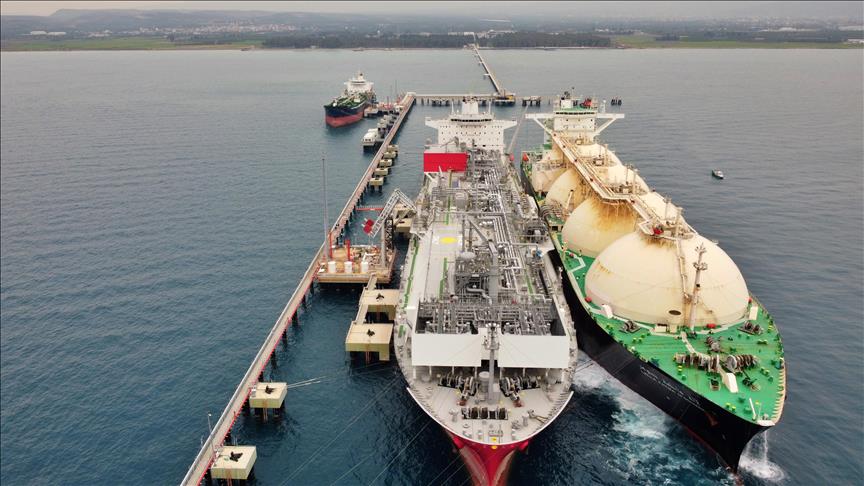

By Anadolu Agency
European Union (EU) countries paid €171.5 billion for liquefied natural gas (LNG) imports over the last two years, out of which €75.1 billion was paid to the US.
Data compiled by Anadolu from the European LNG Tracker published by the Institute for Energy Economics and Financial Analysis (IEEFA) revealed that Europe’s LNG imports totaled approximately 167 billion cubic meters in 2023, similar to 2022.
In 2023, EU countries paid €26.8 billion to the US for LNG, €8.1 billion to Russia, €7.7 billion to Qatar, €6.1 billion to Algeria, €2.9 billion to Norway and €2.8 billion to Nigeria.
Last year, 46% of Europe’s LNG imports originated from the US, 12.1% from Qatar, 11.7% from Russia, 9.4% from Algeria, 5.6% from Nigeria and the rest from other countries.
The EU’s payment to the US for LNG imports in 2022 amounted to €48.34 billion. Russia followed with the second-highest amount at €15.75 billion; imports from Qatar totaled €16.06 billion; €4.78 billion for Algerian supplies; and €4.52 billion each for LNG from Nigeria and Norway.
The EU’s bill to Russia for LNG imports over the last two years reached US$23.84 billion.
Out of all the EU countries, the one that paid the most to the US over the last two years was France, at €22.53 billion. The Netherlands followed with €19.22 billion, Spain with €12.03 billion, Italy with €6.03 billion, Croatia with €3.78 billion, Lithuania with €3.54 billion, Greece with €2.67 billion, Portugal with €2.49 billion, Belgium with €2.48 billion, Finland with €340,000 and Malta with €20,000.
Ana Maria Jaller-Makarewicz, lead energy analyst, Europe, at IEEFA, told Anadolu the data reflects Europe’s aim of diversifying resources, having increased imports from other sources.
She said Norway and the US supplied 30% and 18–19%, respectively, of the EU’s gas imports last year, but paradoxically, the EU paid more for US LNG than for imports of Norwegian gas and LNG.
Jaller-Makarewicz said that as gas markets are becoming riskier, gas and LNG prices are increasingly volatile and are greatly affected by global factors.
‘The uncertainty of future events that could affect gas supply makes it extremely difficult to predict how supply and demand could be balanced and how much prices could escalate. Europe needs to find ways to mitigate that risk. The best way is by reducing internal gas consumption,’ she said.
To this end, she recommended that Europe concentrate on lowering gas use, implement energy-saving measures, increase renewable power and stick to its goal of filling underground gas storage.
– LNG accounts for 37% of Europe’s gas consumption
According to the IEEFA, there is a ‘big discrepancy’ between Europe’s projected LNG demand and its built and planned regasification capacity.
LNG imports accounted for around 37% of Europe’s gas consumption in 2023, compared to 34% in 2022 and 19% in 2021.
Europe’s gas consumption in 2023 fell to a 10-year low of 452 billion cubic meters, 19% below 2021. Between 2021 and 2023, EU gas consumption fell by 20% to 330 billion cubic meters.
The countries that reduced their gas consumption the most in the last two years were Germany with 17.6 billion cubic meters, Italy with 14.4 billion cubic meters, the UK with 14.2 billion cubic meters, the Netherlands with 10.9 billion cubic meters and Türkiye with 9.7 billion cubic meters.
The institute forecasts that European LNG demand will not exceed 135 billion cubic meters in 2030, leaving a potential unused capacity gap of around 265-270 billion cubic meters.
The average utilization rate of the EU’s LNG import terminals in 2023 also fell to 58.5% from 63% in 2022.
Last year, the utilization capacity of a total of eight LNG terminals—four in Spain and one each in Italy, Greece, Finland and Germany—remained below 50%.
Europe has a total of 37 operational LNG import terminals, including in Türkiye, Norway and the UK. Eight of these have been commissioned in the last two years and capacity expansion work has been completed at four terminals.
Europe is expected to increase its total LNG import capacity by 94 billion cubic meters to 405 billion cubic meters by 2030.
According to IEEFA data, total LNG import capacity in Europe has increased by 53.5 billion cubic meters since the start of the Russian-Ukrainian War in February 2022 with 12 LNG projects, including Türkiye’s Saros Floating LNG Storage and Regasification Unit (FSRU).
We use cookies on our website to give you a better experience, improve performance, and for analytics. For more information, please see our Cookie Policy By clicking “Accept” you agree to our use of cookies.
Read More